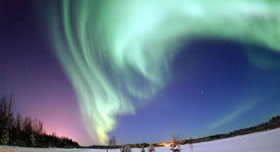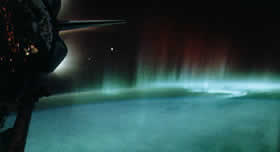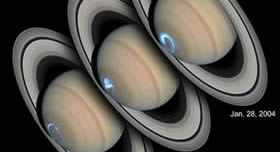Solar Wind
10.10 - Understand the nature, composition and origin of the solar wind10.11 - Understand the principal effects of the solar wind, including:
a} aurorae
b} cometary tails
c} geomagnetic storms
d} the effects on satellites, aircraft travel and manned missions
10.12 - Know the shape and position of the Earth’s magnetosphere including the Van Allen Belts
Solar Wind
The solar wind is a constant flow of charged protons and electrons flowing outward from the Sun. They can reach a velocity of 400 km per second. These particles escape the gravity of the Sun because they have too much energy.
The Sun also produces intense solar flares, or 'coronal mass ejections' (CME).These are violent outbursts of particles that blast away from the sun in all directions. It is more likely we experience the effects on Earth when these occur. Scientists are able to predict if any of these are directed to Earth by satellites that constantly study the 'weather' of the Sun and are able to warn of such events at least 24 hours before they may hit Earth.
The Solar wind has many effects in the Solar System, notably producing tails on comets and aurorae at the poles of certain planets.
Van Allen Belts
Imagine the Earth as a magnet, producing a magnetic field surrounding it. This is caused by Earth’s large iron core and the rotation of the Earth.
This field is called the Magnetosphere. This extends in the direction of the Sun but much further in the opposite direction, even further than the distance to the Moon. It deflects the damaging effects of the solar wind. Some of these charged particles get trapped in two belts of magnetism called the Van Allen Belts. The outer belt is located 5,000 to 6,000 km from the Earth and contains electrons from the Sun. The inner belt is located between 1,000 to 3,000 km away and contains trapped protons.
They are named after Dr James Van Allen who discovered them in 1958.
Effects
Aurorae
The particles that get caught in the Van Allen Belts then move along these field lines toward the magnetic north and south poles and observers in these location witness aurorae.
These are spectacular displays of light and colour in the sky. In the northern hemisphere this is called Aurorae Borealis. In the southern hemisphere this is Aurora Australis.
The intensity of the aurorae depends on the ferocity of the solar wind which in turn depends on the level of solar activity.
They are best seen nearer the magnetic poles, near the (ant)arctic circles and near the equinox (March and September) although some sightings have been reported as far south as the north of Scotland.
Comets
As comets move nearer the sun the sun's radiation is responsible for heating a comet and the solar wind particles will interact with the comet and form a tail which points away from the Sun.
Geomagnetic Storms
This is the effect of an increase of plasma hitting the magnetic field of Earth after a violent CME. In 1859 telegraph systems showed an increase in voltage and observatories recorded a dramatic increase in sunspot activity. This was accompanied by aurorae that could be seen at lower latitudes of the northern hemisphere. This was known as the Carrington Event.
In 1989 a similar event caused by increases of geomagnetic electrical lead to the breakdown of mass electricity systems throughout Northern America.
Satellites, Aircraft travel and Manned space missions
Satellites are vulnerable, not just to direct damage but the increased wind on Earth's atmosphere can heat up the upper atmosphere and affect satellites delicate orbits. GPS and navigational systems are especially at risk to solar disruption meaning huge problems on users who rely on them.
An upper layer of Earth's atmosphere called the ionosphere is used by radio signals and these are particularly affected by solar activity. This makes the essential radio communication of aircraft difficult. A potential issue is the effect on flight crew’s health if traveling at high altitude during an eruption.
High energy particles can cause radiation poisoning, astronauts are especially vulnerable. Those working on the ISS are advised to move to a shielded area on the station.
It is important to remember the Earth's atmosphere protects us while we are on the surface and only some technologies are vulnerable.
Animation
Questions
- Explain the influence of the solar wind on Earth.
- Explain the influence of the solar wind on the Van Allen Belts.
- Where on Earth are Aurorae most likely to be seen?
- What causes Aurorae?
Summary
The interaction of the solar wind on Earth's magnetic field causes aurorae at northern and southern latitudes.
See Also
Links
- Space Weather Check current conditions
- Earth's magnetosphere, Van Allen Belts & aurorae Relationship between the three
- Welcome to AuroraWatch UK Where to find Aurora
- FusEdWeb: Fusion Energy Educational Web Site Solar wind





 | © All Rights Reserved |
| © All Rights Reserved |